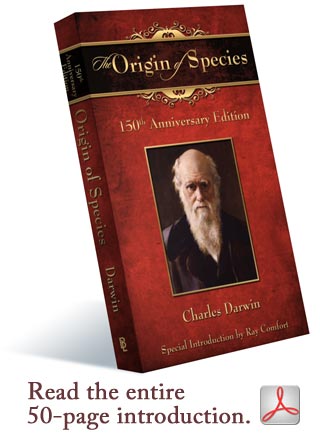This out of the first round of an online "debate" between Scott and the author of the the "unusual" edition of Darwin's book, Ray Comfort (you can read his defense of the book here).
From Ray Comfort's website [bold emphasis mine]:
In November of 2009, we will be giving away more than 100,000 copies of Charles Darwin's On Origin of Species [sic] at 100 top U.S. universities (other individuals and churches have purchased approximately 70,000 copies to also give to students). This will be the entire publication (304-pages). Nothing has been removed from Darwin’s original work. As usual with reprints of On Origin of Species (there have been over 140 reprints), there will be an Introduction. My name will be on the cover (for those who think that we are somehow being deceptive). In one day, 170,000 future doctors, lawyers and politicians will freely get information about Intelligent Design (and the gospel) placed directly into their hands!
...
Sincerely,
Ray Comfort
[Source]
I've posted previously about this subject, here, here, here and here and if this latest news is true, I think it may reveal much about Ray Comfort's intellect and integrity. Taken at face value, it seems he is a deeply and willfully ignorant person when it comes to science - an interpretation consistent with his previous statements on the subject. Secondly, he looks the part of a very dishonest individual who seems willing to (intentionally?) mislead his critics and America's youth in order to propagate his own particular variety of fundamentalist Christianity.
Understandably, Comfort has received a lot of heat for trying to evangelize to students under such false pretenses - and he seems to be feeling it. From elsewhere on his website...
"From now on I will refuse to answer questions about the book or its contents," Comfort said, "because there is such a deep-rooted anger in the atheist world about this publication.Poor guy doesn't even understand why some find his actions so repugnant! People just don't like dishonesty, and lately Ray seems to just wreak of the stuff.
"They desperately want to stop us," he said, "and I don't want to give away any further details regarding the campaign."
...
Comfort argues the book has not been altered at all.
"The 304-page publication will be Charles Darwin's every word - not one jot nor tittle will be removed," he said. [Source]
So what should students do if they happen upon a copy Ray Comfort's "abridged" version of Darwin's On the Origin of Species this fall? Dr. Scott has some advice...
But there's no reason for students to refuse Comfort's free—albeit suspiciously abridged—copy of the Origin. Read the first eight pages of the introduction, which is a reasonably accurate, if derivative, sketch of Darwin's life. The last 10 pages or so are devoted to some rather heavy-handed evangelism, which doesn't really have anything to do with the history or content of the evolutionary sciences; read it or not as you please.To that I'll add two parting points. First, if you are so lucky as to pick up a copy (or twelve) of the book - please remember that I'd love to have one! Second, the full text of Darwin's Origin is available free (on the web) from a variety of sources - doesn't the fact that Ray Comfort omitted those chapters make you wonder what parts he found so objectionable? ;)
But don't waste your time with the middle section of the introduction, a hopeless mess of long-ago-refuted creationist arguments, teeming with misinformation about the science of evolution, populated by legions of strawmen, and exhibiting what can be charitably described as muddled thinking.
For example, Comfort's treatment of the human fossil record is painfully superficial, out of date, and erroneous. Piltdown Man and Nebraska Man—one a forgery, the other a misidentification, both rejected by science more than 50 years ago—are trotted out for scorn, as if they somehow negate the remaining huge volume of human fossils. There are more specimens of "Ardi" (the newly described Ardipithecus ramidus) than there are of Tyrannosaurus —and any 8-year-old aspiring paleontologist will be delighted to tell you how much we know about the T. rex!
Related Links:
- You Don’t Always Need to Be Fair and Balanced | Friendly Atheist
- Scott vs. Comfort | Pharyngula
- Ray Comfort replies to Eugenie Scott | Pharyngula
[Missing chapters going back in for second round of printing.] - Scientist Genie Scott's Last Word to Creationist Ray Comfort: There You Go Again









![[CLICK TO ENLARGE]](http://i48.photobucket.com/albums/f226/MileHighReptile/7.jpg)




